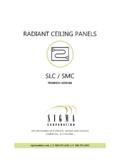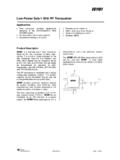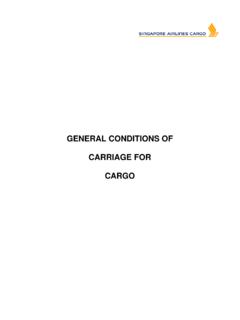Transcription of TECHNICAL CATALOG - Sigma Products
1 TECHNICAL CATALOG | T. | F. 2 Model Number Breakdown .. 10 Details .. 11 Detailed Descriptions, Availability & Applicability .. 13 Main Unit Dimensions .. 21 Discharge Nozzle Dimensions .. 20 Heat Throw .. 21 Sound Class .. 23 LTWW Application Performance Data .. 24 ULWW Application Performance Data .. 35 Correction Factors .. 46 3 OVERVIEW The Sigma UHHL Unit Heater product family covers a wide performance range and is ideally suited to low-temperature warm-water applications. These are loosely defined as hydronic heating applications where the Entering Water Temperature (EWT) is 140 F or less. Typical applications include: condensing boiler installations or low-grade waste-heat systems. In more general terms, the UHHL models are ideally suited wherever the combination of the fluid-to-air thermal gradient is low and/or required water-side Delta-T is high and/or a high-ratio glycol solution is utilized.
2 The overall product range is consolidated to reduce the number of different models, simplifying selection, ordering and installation activities. A comprehensive set of options are offered to meet the most demanding of applications including use in hazardous locations and/or wet or corrosive environments and also at elevated supply water pressures. All units feature side-entry coil connections permitting installation in clearance-critical low ceiling environments. PERFORMANCE All units are designed for maximum heat transfer capacity per given unit size and for optimum air distribution given a variety of possible installation applications. CONFIGURATION All units are equipped with multi-row coils for enhanced unit capacity and water-side Delta-T under given low fluid (water/glycol)-to-air temperature gradients. All units are equipped with horizontal louvers for simple vertical air distribution adjustment.
3 Optional Louver Fin Diffusers (LFDs) permit enhanced air distribution adjustment. That is to say, LFDs can be positioned to create a nozzle effect for increased discharge air throw; or conversely, positioned to deliver a broad air pattern for near field but wide coverage. In addition, a Discharge Nozzle option permits for increased mounting height and longer discharge air throws. All units also can also be configured with a number of line-voltage and/or 24 VAC enabled control options, whether unit-mounted and/or shipped-loose for field installation to complete the facilitate the overall procurement of required components per jobsite conditions. 4 Although, Leaving Water and Air Temperatures (LWT & LAT) are important factors for equipment selection, they take on much more importance within Low-Temperature Warm-Water (LTWW) applications. In general traditional Hot Water Unit Heaters simply cannot meet these new LTWW application requirements while also meeting new additional constraints on LWT & LAT.
4 The following explains the pitfalls and the design considerations for proper Unit Heater (UHHL) selections in LTWW applications. Firstly, LWT Needs To Be More Closely Checked and Considered. In many Low-Temperature Warm-Water (LTWW) applications, the operation of the heat generator is highly dependent upon the return water temperature from the terminal units (unit heaters, etc.). It is very important for the system designer to understand how the system heat source operates. A system driven by condensing boilers will only operate at optimum efficiency if the flue gases from the boiler condense. The Dew Point of the flue gases (with Natural Gas fired equipment) range from roughly 125 to 135 F (depending on % of excess air). At 20% excess air for stoichiometric combustion, exhaust flue gas dew point is 132 F. It is therefore imperative that the flue gas cooling medium (return water) be sufficiently cooler to enable the boiler to condense.
5 In this case, the return water temperature (LWT) is generally below 120 F, and, in many cases closer to 100 F. Standard Unit Heaters (typically constructed with 1 or 2 row s of heating coil) are not inherently designed with sufficient serpentine circuiting to result in such untraditional cool LWTs. Why Lowering Water-Flow (GPM) To Obtain Lowest Possible Leaving Water Temperature Is Rarely The Correct Solution. To obtain low LWTs, isn t it a simple case of throttling the water-flow to increase the water-side delta-T ? No, in these LTWW applications, this is often not a good idea, especially when applying equipment originally designed for traditional (160-200 F EWT ) hot water applications. The simple answer is that at significantly lower flow rates than design, the water-flow through the heat exchanger (AL-fin CU-tube coil) may fall into the laminar regime. If this happens, heat transfer capacity decreases significantly.
6 To the best of our knowledge, no one in the industry publishes real capacity data taking into account a decreased capacity due to operation of their equipment in the laminar regime. It is as if everyone conveniently forgets that Laminar Flows and their effects exist. Be assured that the Sigma UHHL capacity tables, herein, exclude any selections which that have flow velocities in the Laminar regime. The table below lists the minimum permissible flow velocities and flow rates based on laminar and transitional flow regimes. Table - Minimum Allowable Flow Rates* With 1/2" OD Tubes Min. Velocity [ft/s] Min. Flow Rate* [US gpm] With 5/8" OD Tubes Min. Velocity [ft/s] Min. Flow Rate* [US gpm] Fluid Temperature: 120 F 180 F 120 F 180 F 120 F 180 F 120 F 180 F Fluid Temperature : Water - Water - Propylene Glycol 20% Propylene Glycol 20% 30% 30% 40% 40% 50% 50% *Flow rate is expressed on a per circuit basis.
7 Most finned-tube heat exchangers consist of several circuits. 5 At first glance, these minimum flow velocities and flow rates appear to be much lower than what is generally used in the hydronic heating industry. The main driver is the increased viscosity. The viscosity of glycol solutions is too often solely viewed as its only significant effect is to increase water pressure drop, but its effect upon the resultant flow regime (expressed as a Reynolds number) is not nearly as understood nor accounted for. Viscosity of Propylene Glycol Solutions From the above graph, we can gather the following values for the viscosity (cP) for various Water / Propylene solutions and/or conditions : Water : @180 F = , @120 F = ; ratio = PP-20%: @180 F = , @120 F = ; ratio = PP-30%: @180 F = , @120 F = ; ratio = PP-40%: @180 F = , @120 F = ; ratio = PP-50%: @180 F = , @120 F = ; ratio = Because the viscosity increases significantly with both lower fluid temperatures and higher concentrations, the effect on the flow characteristics within the Unit Heater cannot be ignored.
8 These effects are two-fold. Firstly, the water pressure drop will rise. For smooth pipes or tubes (as is the case with typical Copper-Tube Aluminum-Fin heat exchangers) the relationship between pressure drop and viscosity is roughly proportional, that is, a doubling of viscosity causes a doubling in pressure drop. So, in glycol systems, it is generally good practice to limit flow velocities. However and secondly, we have the Reynolds Numbers effects. What is generally meant by this, is that the flow regime may in one of 3 zones (or types of flow): a) laminar, b) transitional or c) turbulent. All heating/cooling equipment should be designed and applied to ensure that the flow regimes remain turbulent within the applicable range of the product. TABLE is based on a threshold Reynolds Number (Re) of 2500. Although there is some disagreement within the scientific / engineering community as to the exact threshold Re No.
9 For Laminar and Turbulent Flow, Sigma has used a value for Re of 2500 to establish a rule which can be broadly applied without being overly conservative nor fool-hardly optimistic. Since Re is directly proportional to velocity, it is generally good practice to keep velocities away from the laminar region, that is, to avoid low flow velocities. Obviously, we have a conflict and the more viscous the fluid (cooler temperatures and/or glycol mixtures)the worse the situation with a narrower range of permissible flow velocities within the heat exchanger. This is a fundamental reason where and why these LTWW applications require a new and specific design solution for its terminal heating units given that standard unit heaters do not comply from a system point of view. In the preceding charts and discussion, only data for water and for propylene glycol mixtures is given. Please note that Ethylene Glycol mixtures will behave in a very similar fashion to that of Propylene.
10 6 Table - Flow Range Ratio ** 1/2" OD Tubes 5/8" OD Tubes Fluid Temperature: 120 F 180 F 120 F 180 F Water - 15 24 19 30 Propylene Glycol 20% 9 16 11 20 30% 7 13 8 16 40% 5 10 6 13 50% 4 8 5 10 **Flow Range Ratio is the ratio of Maximum Practical Velocity (6 ft/s) vs Minimum as listed on page 4. So far, we ve only discussed the physics at low velocities but what about at high flow velocities ? At high flow velocities, our only concern is the increasing fluid pressure drops, there are no fundamental show-stoppers (similar to Laminar Flow) that manifest. As such, the same maximum velocity rule can apply regardless of fluid and temperature. As a maximum upper bound, fluid velocities should be limited to no more than ft/s since velocities exceeding ft/s will accelerate dramatically erosion of the copper tubes. However, in a practical sense, water pressure drops become much too high for most applications and thus, designs are usually limited to a maximum that is closer to 6 ft/s; with most ideal selections in the 4 ft/s range.











